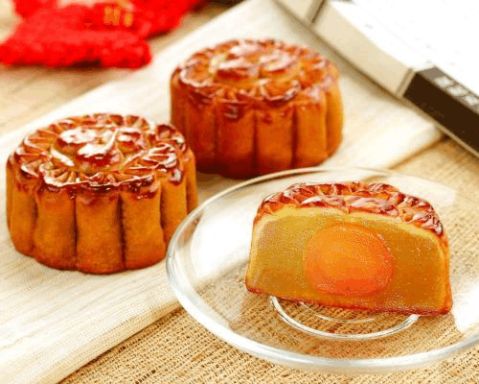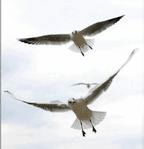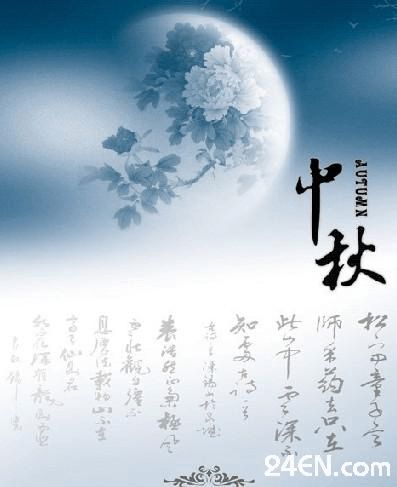英文版中秋节介绍
英文版中秋节介绍,分享中秋
2010-09-26 08:35:37| 分类: | 标签: |字号大中小 订阅
"Zhong Qiu Jie", which is also known as the Mid-Autumn Festival, is celebrated on the 15th day of the 8th month of the lunar calendar. It is a time for family members and loved ones to congregate and enjoy the full moon - an auspicious symbol of abundance, harmony and luck. Adults will usually indulge in fragrant mooncakes of many varieties with a good cup of piping hot Chinese tea, while the little ones run
around with their brightly-lit lanterns.
农历八月十五日是中国的传统节日——中秋节。在这天,每个家庭都团聚在一起,一家人共同观赏象征丰裕、和谐和幸运的圆月。此时,大人们吃着美味的月饼,品着热腾腾的香茗,而孩子们则在一旁拉
着兔子灯尽情玩耍。
"Zhong Qiu Jie" probably began as a harvest festival. The festival was later given a mythological
flavour with legends of Chang-E, the beautiful lady in the moon.
中秋节最早可能是一个庆祝丰收的节日。后来,月宫里美丽的仙女嫦娥的神话故事赋予了它神话色
彩。
According to Chinese mythology, the earth once had 10 suns circling over it. One day, all 10 suns appeared together, scorching the earth with their heat. The earth was saved when a strong archer, Hou Yi, succeeded in shooting down 9 of the suns. Yi stole the elixir of life to save the people from his tyrannical rule, but his wife, Chang-E drank it. Thus started the legend of the lady in the moon to whom
young Chinese girls would pray at the Mid-Autumn Festival.
传说古时候,天空曾有10个太阳。一天,这10个太阳同时出现,酷热难挡。弓箭手后翌射下了其中9个太阳,拯救了地球上的生灵。他偷了长生不死药,却被妻子嫦娥偷偷喝下。此后,每年中秋月圆之
时,少女们都要向月宫仙女嫦娥祈福的传说便流传开来。
In the 14th century, the eating of mooncakes at "Zhong Qiu Jie" was given a new significance. The story goes that when Zhu Yuan Zhang was plotting to overthrow the Yuan Dynasty started by the Mongolians, the rebels hid their messages in the Mid-Autumn mooncakes. Zhong Qiu Jie is hence also a
commemoration of the overthrow of the Mongolians by the Han people.
在14世纪,中秋节吃月饼又被赋予了一层特殊的含义。传说在朱元璋带兵起义推翻元朝时,将士们曾把联络信藏在月饼里。因此,中秋节后来也成为汉人推翻蒙古人统治的纪念日。 字串7 During the Yuan Dynasty (A.D.1206-1368) China was ruled by the Mongolian people. Leaders from the preceding Sung Dynasty (A.D.960-1279) were unhappy at submitting to foreign rule, and set how to coordinate the rebellion without it being discovered. The leaders of the rebellion, knowing that the Moon Festival was drawing near, ordered the making of special cakes. Packed into each mooncake was a message with the outline of the attack. On the night of the Moon Festival, the rebels successfully attacked and overthrew the government. What followed was the establishment of the Ming Dynasty (A.D.
1368-1644). Today, moon cakes are eaten to commemorate this event.
在元朝,蒙古人统治中国。前朝统治者们不甘心政权落入外族之手,于是密谋策划联合起义。正值中秋将近,起义首领就命令部下制作一种特别的月饼,把起义计划藏在每个月饼里。到中秋那天,起义军
获取胜利,推翻了元朝,建立明朝。今天,人们吃月饼纪念此事。
Mid-Autumn Day 中秋节
Mid-Autumn Day is a traditional festival in China. Almost everyone likes to eat mooncakes on that day. Most families have a dinner together to celebrate the festival. A saying goes, "The moon in your hometown is almost always the brightest and roundest". Many people who live far away from homes want to go back to have a family reunion. How happy it is to enjoy the moon cakes while watching the full
moon with your family members.
第二篇:用英文介绍传统中秋节
Chinese Mid-autumn Festival
The 15th day of the 8th lunar month ,the joyous Mid-Autumn Festival was
on the fifteenth day of the eighth moon, around the time of the
autumn equinox(秋分). Many referred to it simply as the "Fifteenth of the Eighth Moon".
This day was also considered as a harvest festival since fruits, vegetables and grain had been harvested by this time and food was abundant. Food offerings were
placed on an altar set up in the courtyard. Apples, pears, peaches, grapes,
pomegranates(石榴), melons, oranges and pomelos(柚子) might be seen. Special foods for the festival included moon cakes, cooked taro(芋头)and water caltrope(菱角), a type of water chestnut resembling black buffalo horns. Some people insisted
that cooked taro be included because at the time of creation, taro was the first food discovered at night in the moonlight. Of all these foods, it could not be omitted from the Mid-Autumn Festival.
The round moon cakes, measuring about three inches in diameter and one and a half inches in thickness, resembled Western fruitcakes in taste and
consistency. These cakes were made with melon seeds(西瓜子), lotus seeds(莲籽), almonds(杏仁), minced meats, bean paste, orange peels and lard(猪油). A golden yolk(蛋黄) from a salted duck egg was placed at the center of each cake, and the golden brown crust was decorated with symbols of the festival. Traditionally, thirteen moon cakes were piled in a pyramid to symbolize the thirteen moons of a
"complete year," that is, twelve moons plus one intercalary(闰月的) moon.
The Mid-Autumn Festival is a traditional festivity for both the Han and minority nationalities. The custom of worshipping the moon can be traced back as far as the ancient Xia and Shang Dynasties (2000
B.C.-1066 B.C.). In the Zhou
Dynasty(1066 B.C.-221 B.C.), people hold ceremonies to greet winter and worship the moon whenever the Mid-Autumn Festival sets in. It becomes very
prevalent in the Tang Dynasty(618-907
A.D.) that people enjoy and worship the full moon. In the Southern Song Dynasty (1127-1279 A.D.), however, people send round moon cakes to their relatives as gifts in expression of their best wishes of family reunion. When it becomes dark, they look up at the full silver moon or go sightseeing on lakes to the
festival. Since the Ming (1368-1644 A.D. ) and Qing Dynasties (1644-1911A.D.), the custom of Mid-Autumn Festival
celebration becomes unprecedented popular. Together with the celebration there appear some special customs in different parts of the country, such as burning incense(熏香), planting
Mid-Autumn trees, lighting lanterns on towers and fire dragon dances. However, the custom of playing under the moon is not so popular as it used to be nowadays, but it is not less popular to enjoy the
bright silver moon. Whenever the festival sets in, people will look up at the full silver moon, drinking wine to their happy life or thinking of their
relatives and friends far from home, and extending all of their best wishes to them. Moon Cakes

There is this story about the moon-cake. during the Yuan dynasty (A.D. 1280-1368) China was ruled by the Mongolian people. Leaders from the preceding Sung dynasty
(A.D. 960-1280) were unhappy at submitting to the foreign rule, and set how to coordinate the rebellion without being discovered. The leaders of the rebellion, knowing that the
Moon Festival was drawing near, ordered the making of special cakes. Backed into each
moon cake was a message with the outline of
the attack. On the night of the Moon Festival, the rebels successfully attached and
overthrew the government. Today, moon cakes are eaten to commemorate this legend and was called the Moon Cake.
For generations, moon cakes have been made with sweet fillings of nuts, mashed red beans, lotus-seed paste or Chinese dates(枣子), wrapped in a pastry. Sometimes a cooked egg yolk can be found in the middle of the rich tasting dessert. People compare moon cakes to the plum pudding and fruit cakes which are served in the English holiday seasons.
Nowadays, there are hundreds varieties of moon cakes on sale a month before the arrival of Moon Festival.


-
英语作文自我介绍 带翻译
英语作文自我介绍带翻译Tointroducemyself介绍我自己Helloeveryone大家好Mynameis我叫I39ma1…
-
自我介绍英语(中文翻译)
GoodmorningMynameisxxxItisreallyagreathonortohavethisopportunitytointroduce…
-
英语作文自我介绍 带翻译
英语作文自我介绍带翻译英语作文自我介绍带翻译Tointroducemyself介绍我自己Helloeveryone大家好Mynam…
-
英语作文自我介绍 带翻译
英语作文自我介绍带翻译英语作文自我介绍带翻译Tointroducemyself介绍我自己Helloeveryone大家好Mynam…
-
英语作文自我介绍_带翻译
英语作文自我介绍带翻译Tointroducemyself介绍我自己Helloeveryone大家好Mynameis我叫I39ma1…
-
教师年度思想工作总结
回顾这一学期,有许多值得总结和反思的地方。现将本学期的工作做一个总结,借以促进我今后工作的进一步提高。一、加强学习,不断提高思想业…
-
医教科20xx年上半年工作总结
20xx年上半年医教科在院长、分管院长的领导下,以二甲复评工作为契机,围绕以人为本、科学发展,维护医疗质量与安全,不断学习、提高人…
-
党风廉政建设个人工作总结2
党风廉政建设个人工作总结一年来,持续深化思想作风和廉政建设,以身作则,树立正人先正己思想,切实履行区政府党风廉政建设第一责任人的职…
-
农村学校新进教师管理与服务工作总结材料()
农村学校新进教师管理与服务工作总结材料我市自20xx年启动实施“农村学校每校每年新进一名新教师”计划以来,先后有7名新教师来我校任…
-
第八届校园文化艺术节活动总结
20xx-20xx学年度第二学期校园文化艺术节活动总结为了激发学生的爱国情感,加强学生艺术教育,丰富师生课余生活,我校组织开展了校…